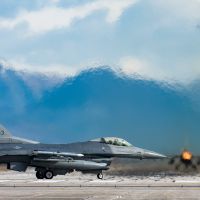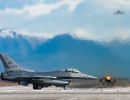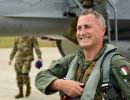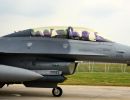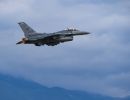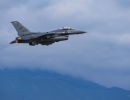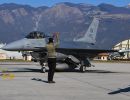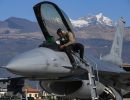March 31, 1993 -- UNSCR 816 extends the ban to cover all flights not authorized by UNPROFOR and authorizes member states to take all necessary measures to ensure compliance with the ban.
April 12,1993 -- NATO Operation Deny Flight begins at noon GMT with aircraft from France, the Netherlands and the United States. F-15C Eagles, deployed to Aviano from Bitburg AB, Germany, are among the first to enforce Deny Flight against fixed-wing and rotary aircraft operating in the UN "No-Fly Zone."
Aug 2,1993 -- The North Atlantic Council makes immediate preparations for stronger measures, including air strikes, against those responsible for the strangulation of Sarajevo and other are as in Bosnia-Herzegovina, and for wide scale interference with humanitarian aid.
Fed 9,1994 -- The NAC decides that 10 days after midnight GMT, Feb. 10, heavy weapons not removed from a 20-kilometer exclusion zone around Sarajevo or turned over to United Nations control would be subject to NATO air strikes. The efforts of NATO and the United Nations result in the withdrawal of heavy weapons from Sarajevo and placement under U.N. control.
Fed 28,1994 -- Four NATO F- 16s, including two deployed to Aviano from Ramstein AB, Germany, shoot down four Galeb fixed-wing aircraft violating the U.N. "No-Fly Zone." The two Ramstein pilots and their aircraft presently are assigned to the 31st Fighter Wing.
April 10, 1994 -- UNPROFOR military observers in the Bosnian city of Gorazde ask for NATO air protection. Close air support is provided by Aviano-deployed F-16s from Ramstein AB and Marine F/A- 18s from Beaulort Marine Corps Air Station, S.C., which bomb and strafe targets near Gorazde.
Aug. 5, 1994 -- Ignoring repeated warnings from UNPROFOR, the Bosnian Serb Army seizes a 76mm anti-tank gun and other heavy weapons from a U.N. storage center. UNPROFOR requests NATO launch an attack on the confiscated weapons. Aviano-deployed A- I O aircraft get the call and destroy the antitank gun. The BSA returns the weaponry to United Nations forces the following day.
Sept. 22, 1994 -- Following a Bosnian Serb attack against a French arrnoured personnel carrier near Sarajevo, NATO aircraft attack a Serb tank inside the 20-kilometer exclusion zone around Sarajevo. The UNPROFOR-requested airstrike is carried out by Air Force OA-10 and British Jaguar aircraft.
Nov. 21, 1994 -- NATO aircraft attack the Udbina airfield in Serb-held Croatia. The air strike is in response to attacks launched from the airfield against targets in the Bihac area of Bosnia Herzegovina a few days earlier. More than 20 Aviano-based aircraft, including F-16s and Marine F/A- I 8s take part in the strike which also includes French, Dutch and British aircraft operating out of other Italian air bases.
Nov. 23, 1994 -- Following a surface-to-air missile attack the previous day on NATO aircraft, NATO reconnaissance aircraft are accompanied by escorts. After the aircraft are illuminated by SAM radars, NATO aircraft attack the SAM sites at Otoka and Dvor, firing high-speed anti-radiation missiles. Later the same day, NATO conducts a strike against the Otoka SAM site.


